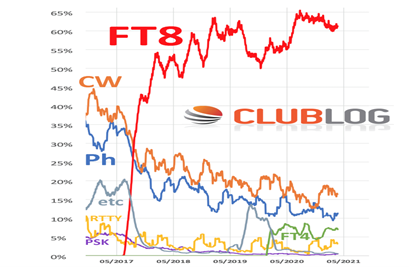Let me start by saying that this is an OPINION PIECE. Everybody has an opinion. Everyone is entitled to his or her opinion. I try to explore all sides, but I am also an admitted FT8 fan. I’ve never known a good sun. I am also fascinated with polarized opinions.
Let’s start off with HF propagation. It largely depends on sunspots, and sunspots tend to ebb and peak on an 11-year cycle. In the last few years, we have been in a deep low part of the cycle and even the last few peaks have not been very good. If people had started experimenting with radio during a sunspot low, they might have decided radio wasn’t very practical. With low sunspot activity, higher frequencies don’t propagate well at all. Lower frequencies might get through, but those require much larger antennas and that causes other problems.

Enter Weak Signal Propagation Reporter (WSPR, pronounced “whisper”). It is a protocol, implemented in a computer program, used for weak-signal radio communication between amateur radio operators. You’ve read about it by this point. You know what it is and most even know how it works. But what there really is are VERY strong opinions. Google FT8 and you’ll find people who detest it. Here’s just one example:
There’s no need for an antenna. No need for some power. Hell, no need for a microphone or a CW key (or keyer)! You just need some computer software where your computer can earn ARRL’s DXCC in a day!
FT8 isn’t rebellious, it’s stupid. In my opinion FT8 is like a self-driving car. No operating skills required. How much fun is sitting in a car you’re not driving? You get my point?

Other people will argue that FT8 is saving ham radio, singing its praises about how the other modes are dead while this one is thriving. New operators are earning awards in a mere sliver of the time it took the operators of old.
The pro-FT8 case is laid out in this article from Gerald, K5SDR, CEO of FlexRadio:
- FT8 counters the current dearth of sunspots
- FT8 opens “dead bands”
- FT8 is addictive–see em, click em, work em…Boom!
- FT8 lets little pistols work DXCC like a big gun
- FT8 lets you work the world from small or deed-restricted lots
- FT8 is a weak signal–not a low power mode (power works the really weak ones)
- FT8 lets you work DX on 6m when there would be none
- FT8 is suddenly dominating VHF/UHF contesting
- FT8 lets you work weak signal DX without proficient CW skills
- FT8 is like having constant DX beacons on every band
- FT8 puts the DX, WAS, WAZ, etc. on the air when they might not be
- FT8 lets you work DXCC on 160m without a big station
- FT8 lets you call CQ and become the DX
- FT8 is amazing literally space age technology
- FT8 is probably other things I haven’t realized yet but some of you have
Perhaps one of my favorite lines on the FT8 question comes from an article by Al Williams:
It is popular to blame the new technology for killing things. The Internet killed newspapers. The video killed the radio star. Is FT8, a new digital technology, ready to kill radio with ham? The community seems evenly divided.
The Greek philosopher Heraclitus is credited with the idea that the only constant in life is change. However, the fear of change is also a constant. Humans like routine. It makes us feel in control of our lives. Change does the opposite of that.
So, will FT8 kill ham radio as some have claimed? Yes, it is mostly automated. Yes, it can reduce some skill required to make DX contacts by removing the need for filters and other tuning. Yes, it removes all rag chewing from the QSO. However, the same is true of most DX chasing contacts on any mode, especially contesting.
A few weeks ago, I saw an old car with an even older bumper sticker that said how single sideband killed amateur radio. I smiled and wished I had thought to take a picture. The more things change, the more they stay the same.
Questions? Share them in the comments below or email me at KE8FMJ@arrl.net.

